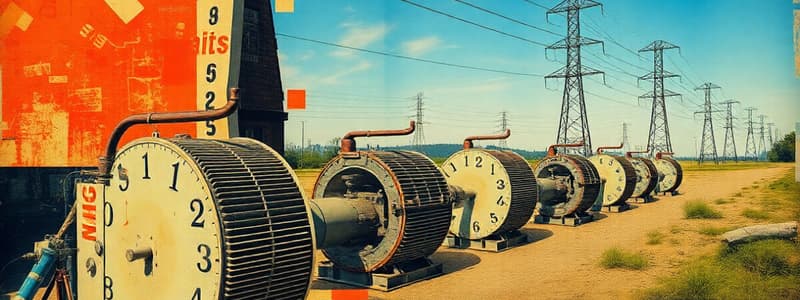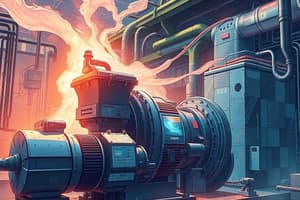Podcast
Questions and Answers
What is a key characteristic of separately excited DC generators?
What is a key characteristic of separately excited DC generators?
- They have lower costs due to no external power requirements.
- The field winding is connected in series with the armature.
- The field winding receives power from an external source. (correct)
- Output voltage is highly dependent on the load.
Which type of DC generator offers better voltage regulation compared to series generators?
Which type of DC generator offers better voltage regulation compared to series generators?
- Compound Wound DC Generators (correct)
- Long Shunt Compound DC Generators
- Self-Excited DC Generators
- Series Wound DC Generators
In which application would you primarily use a series wound DC generator?
In which application would you primarily use a series wound DC generator?
- Stable voltage power supply for laboratory equipment
- Battery charging for safety applications
- Boosters in power transmission systems (correct)
- Electroplating requiring constant voltage
What is the distinguishing feature of shunt wound DC generators compared to the other types?
What is the distinguishing feature of shunt wound DC generators compared to the other types?
Why are separately excited DC generators considered high cost?
Why are separately excited DC generators considered high cost?
Which characteristic of compound wound DC generators allows their voltage regulation to be tailored?
Which characteristic of compound wound DC generators allows their voltage regulation to be tailored?
Which application is NOT typically associated with shunt wound DC generators?
Which application is NOT typically associated with shunt wound DC generators?
What unique property do compound wound DC generators offer over shunt and series generators?
What unique property do compound wound DC generators offer over shunt and series generators?
How do series wound DC generators primarily affect voltage output?
How do series wound DC generators primarily affect voltage output?
What is typically the primary use for separately excited DC generators?
What is typically the primary use for separately excited DC generators?
What is the primary requirement for voltage matching in the parallel operation of DC generators?
What is the primary requirement for voltage matching in the parallel operation of DC generators?
Which type of DC generator is best suited for applications where high starting torque is required?
Which type of DC generator is best suited for applications where high starting torque is required?
What is one key challenge when operating DC generators in parallel?
What is one key challenge when operating DC generators in parallel?
During the parallel connection of DC generators, which of these steps is mandatory?
During the parallel connection of DC generators, which of these steps is mandatory?
What does the equalizing connection in parallel operation of DC generators do?
What does the equalizing connection in parallel operation of DC generators do?
In terms of testing, what does the insulation resistance test measure?
In terms of testing, what does the insulation resistance test measure?
Which of the following ensures proper load sharing among shunt generators in parallel operation?
Which of the following ensures proper load sharing among shunt generators in parallel operation?
What is a significant advantage of paralleling DC generators as per the discussed concepts?
What is a significant advantage of paralleling DC generators as per the discussed concepts?
Which type of testing is crucial for ensuring no short circuits between turns in the winding of a DC generator?
Which type of testing is crucial for ensuring no short circuits between turns in the winding of a DC generator?
What is the purpose of adjusting the field excitation in parallel operation of generators?
What is the purpose of adjusting the field excitation in parallel operation of generators?
What does the short circuit test measure in a generator?
What does the short circuit test measure in a generator?
Which of the following tests is NOT a type test conducted on prototype machines?
Which of the following tests is NOT a type test conducted on prototype machines?
In the context of testing DC generators, what is the primary goal of the dielectric test?
In the context of testing DC generators, what is the primary goal of the dielectric test?
What is assessed during a dynamic performance test?
What is assessed during a dynamic performance test?
Which parameter is primarily evaluated during the load test of a generator?
Which parameter is primarily evaluated during the load test of a generator?
What does the short-time overload test determine?
What does the short-time overload test determine?
Which Indian Standard outlines the requirements for testing methods for DC generators?
Which Indian Standard outlines the requirements for testing methods for DC generators?
What is primarily evaluated in a parallel operation test?
What is primarily evaluated in a parallel operation test?
Which aspect is specifically measured during the efficiency test of a generator?
Which aspect is specifically measured during the efficiency test of a generator?
What does the temperature rise test assess?
What does the temperature rise test assess?
Flashcards
Separately Excited DC Generator
Separately Excited DC Generator
A DC generator where the field winding is powered by a separate external source, making its output voltage independent of the load.
Self-Excited DC Generator
Self-Excited DC Generator
A DC generator that uses the armature current to excite the field winding, requiring no external power source for the field winding.
Shunt Wound DC Generator
Shunt Wound DC Generator
A type of self-excited DC generator where the field winding is connected in parallel with the armature.
Series Wound DC Generator
Series Wound DC Generator
Signup and view all the flashcards
Compound Wound DC Generator
Compound Wound DC Generator
Signup and view all the flashcards
Long Shunt Compound
Long Shunt Compound
Signup and view all the flashcards
Short Shunt Compound
Short Shunt Compound
Signup and view all the flashcards
Voltage Matching (Parallel DC Gens)
Voltage Matching (Parallel DC Gens)
Signup and view all the flashcards
Polarity Matching (Parallel DC Gens)
Polarity Matching (Parallel DC Gens)
Signup and view all the flashcards
Load Sharing (Parallel DC Gens)
Load Sharing (Parallel DC Gens)
Signup and view all the flashcards
Equalizing Connection
Equalizing Connection
Signup and view all the flashcards
Power Supply (DC Generator App)
Power Supply (DC Generator App)
Signup and view all the flashcards
Electrochemical Processes (DC Generator App)
Electrochemical Processes (DC Generator App)
Signup and view all the flashcards
Traction Systems (DC Generator App)
Traction Systems (DC Generator App)
Signup and view all the flashcards
Testing & Lab Use (DC Generator App)
Testing & Lab Use (DC Generator App)
Signup and view all the flashcards
Industrial Applications (DC Generator App)
Industrial Applications (DC Generator App)
Signup and view all the flashcards
Insulation Resistance Test
Insulation Resistance Test
Signup and view all the flashcards
Polarity Test
Polarity Test
Signup and view all the flashcards
IS 4722: Part 1 (1992)
IS 4722: Part 1 (1992)
Signup and view all the flashcards
Routine Tests (DC Generator Testing)
Routine Tests (DC Generator Testing)
Signup and view all the flashcards
Type Tests (DC Generator Testing)
Type Tests (DC Generator Testing)
Signup and view all the flashcards
Special Tests (DC Generator Testing)
Special Tests (DC Generator Testing)
Signup and view all the flashcards
Study Notes
DC Generator Types
- Separately Excited DC Generator: Field winding powered by external source; Output voltage independent of load; Stable and controllable; High cost due to external power source
- Self-Excited DC Generator:
- Shunt Wound DC Generator: Field winding connected parallel to armature; Relatively stable output voltage; Used for constant voltage applications
- Series Wound DC Generator: Field winding connected in series with armature; High starting torque; Voltage varies widely with load; Not suitable for stable voltage applications
- Compound Wound DC Generator: Combination of series and shunt windings; Offers advantages of both; Better voltage regulation than series generators
- Long Shunt Compound: Series winding connected outside the shunt winding
- Short Shunt Compound: Series winding connected inside the shunt winding
DC Generator Applications
- Power Supply: Initial excitation of large AC generators; Battery charging and standby power
- Electrochemical Processes: Electroplating, electro-refining, and other processes requiring DC supply
- Traction Systems: Series-wound generators used for trams, trolleys, and electric locomotives due to high starting torque
- Testing and Laboratory Use: Separately excited generators used for stable and controllable output in research
- Industrial Applications: Welding, electrolysis, and battery charging
Parallel Operation of DC Generators
- Principles:
- Voltage Matching: Terminal voltage of all generators must be the same.
- Polarity Matching: The polarity of the generators must be the same.
- Load Sharing: Generators must share the load according to their capacities.
- Conditions:
- Same Voltage Rating
- Similar Voltage Characteristics
- Methods:
- Equalizing Connection: Equalizing bar connects armature of generators to ensure even load sharing
- Series Field Windings: Series field windings connected in a way that aids the shunt field
- Advantages:
- Increased Reliability: If one fails, the other can continue to supply power.
- Maintenance: Generators can be taken offline for maintenance without interruption
- Flexibility: Additional generators can be added as load increases
- Load Sharing: Efficient distribution, leading to better performance and longer life for each generator
- Challenges:
- Circulating Currents: Occur if terminal voltages don't match, leading to losses and damage
- Hunting: Small oscillations in load sharing, which must be dampened to prevent instability.
- Voltage Regulation: Maintaining voltage regulation with varying loads can be complex.
DC Generator Testing (Indian Standards)
-
Relevant Standard: IS 4722: Part 1 (1992) "Specification for rotating electrical machines, Part 1: General requirements."
-
Routine Tests:
- Insulation Resistance Test: Measures insulation resistance of windings
- Polarity Test: Verifies correct polarity
- Inter-turn Insulation Test: No short circuit between winding turns
- Measurement of Resistance: Determines resistance of windings
- Open Circuit Test: Determines no-load voltage, current, and core losses
- Short Circuit Test: Measures short circuit current, voltage, and losses
- Load Test: Measures performance under load to determine efficiency, voltage regulation, and temperature rise
-
Type Tests:
- Temperature Rise Test: Determines temperature rise during continuous operation
- Efficiency Test: Measures efficiency at various loads
- Voltage Regulation Test: Evaluates ability to maintain constant voltage
- Short-Time Overload Test: Determines overload capability
- Dielectric Test: Checks insulation system's ability to withstand high voltage
- Mechanical Test: Checks strength and stability of the generator
-
Special Tests:
- Transient Stability Test: Evaluates ability to withstand sudden load or voltage changes
- Dynamic Performance Test: Assesses response to load or operating condition changes
- Parallel Operation Test: Verifies ability to operate in parallel without instability
-
Compliance with Indian Standards: Testing procedures must comply with IS 4722: Part 1 (1992).
Studying That Suits You
Use AI to generate personalized quizzes and flashcards to suit your learning preferences.





